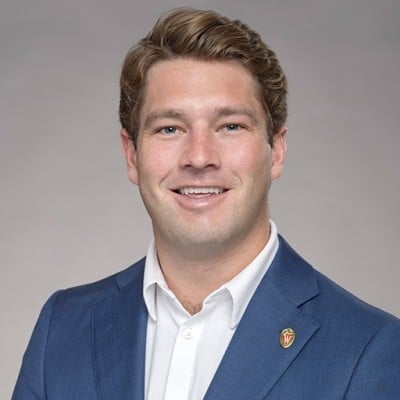3 min read
The Day It All Fell Apart – How We Ended Up Homeless, Unemployed and Backpacking Through Europe
The Day It All Fell Apart – How We Ended Up Homeless, Unemployed and Backpacking Through Europe by Antonio Canas This post was written in...
2 min read
 Fritz Merizon
:
Nov 7, 2025 10:41:57 AM
Fritz Merizon
:
Nov 7, 2025 10:41:57 AM

 In 1957, Northwestern Mutual Life Insurance Company made a bold move for an insurer’s
In 1957, Northwestern Mutual Life Insurance Company made a bold move for an insurer’s
balance sheet. Seeking uncorrelated returns, they financed the construction of a Great Lakes
freighter as a direct corporate investment. The vessel, launched in 1958 and named after the
company’s chairman, Edmund Fitzgerald. Fitzgerald was actually strongly against the company
naming the vessel after him. Perhaps he had some type of uncanny foresight.
The ship cost approximately $8.4 million, or nearly $100 million in today’s dollars, making it the
most expensive Great Lakes freighter of its day [3]. Northwestern Mutual owned the vessel and
chartered it to Oglebay Norton Corporation, a mining company operating freighters on the Great
Lakes [3]. Starting in 1958, the atypical insurance asset transported millions in cargo and was
among the premiere Great Lakes shipping vessels before its demise in 1975.
On this day 50 years ago, the Edmund Fitzgerald sank in Lake Superior on a routine passage
that turned fatal due to the unpredictable nature of the lake’s weather. The loss claimed 29 lives
and totaled an estimated $24 million direct loss (including its cargo of 26,116 long tons of
taconite pellets), the largest loss in Great Lakes shipping history [1].
What were the insurance implications? Immediately, the sinking triggered multiple coverages:
hull, cargo, and liability. While the vessel sank in Canadian waters, U.S. law applied as it was an
American-flagged ship [5], opening the door for two widows to file a $1.5 million wrongful-death
lawsuit against Northwestern Mutual and Oglebay Norton almost immediately. Shortly after, it
was followed by another for a $2.1 million suit [1]. Confidential settlements were reached about
a year later [5].
The U.S. Coast Guard’s official report blamed the sinking on ineffective hatch closures and
flooding of the cargo holds. Public skepticism has produced a number of alternative theories
including structural failure, rogue waves, and even overloading [1]. The report notably stopped
short of assigning direct fault to the owner or captain, which mitigated liability exposure for
Northwestern Mutual and its chartering partners, likely reducing the settlement amounts for the
widowed families.
The Fitzgerald wreck led to changes in both maritime safety and marine insurance underwriting.
Regulators required improved weather forecasting, depth finders, position-fixing systems (AIS),
survival suits, increased freeboard (height of the ship off the water), and more frequent vessel
inspections [2]. These changes drove insurers to tighten underwriting standards for Great Lakes
vessels, revise premium models, and demand higher documentation of maintenance and crew
training.
Since 1975, there have been no major disasters on the scale of The Fitzgerald wreck, indicating
that these reforms materially reduced catastrophic risk [2].
For the insurance industry, the Edmund Fitzgerald shows the risks of pursuing higher returns
through nontraditional assets. There’s a good reason why insurers like bonds, and a better
reason why no major insurers own ships these days. Northwestern Mutual’s decision led them
to taking on a great amount of operational risk, which is a big jump from simply pricing the risk,
which is their core business. After all, Northwestern Mutual had little expertise in owning and
operating freight ships.
The case highlighted how ownership structure complicates insurance exposure. Northwestern
Mutual being the owner of the vessel presented different risk exposure. The company bore
operational and liability risks that insurers typically transfer, not assume themselves.
The event also reinforced the importance of transparent loss investigation, fair claims
settlement, and prudent asset diversification. Today, folks in the industry still cite the Fitzgerald
as a case study in how complex ownership structures and operational exposure can present
risks that insurers and regulators are often uncomfortable with.
Works Cited
1. Canada EHX. (2022). The Edmund Fitzgerald. Retrieved from
https://canadaehx.com/2022/01/08/the-edmund-fitzgerald/
2. O’Bryan Law. (2016). The Edmund Fitzgerald – 41 Years Later. Retrieved from
https://obryanlaw.net/the-edmund-fitzgerald-41-years-later/
3. Shipwreck Museum. (n.d.). SS Edmund Fitzgerald. Retrieved from
https://shipwreckmuseum.com/edmund-fitzgerald/
4. The Gazette. (2020, June 8). Time Machine: The Edmund Fitzgerald—The Ill-Fated Ship
Bore the Name of Insurance Company President. Retrieved from
https://www.thegazette.com/history/time-machine-edmund-fitzgerald-the-ill-fated-ship-
bore-name-of-insurance-company-president/
5. Wikipedia. (2024). SS Edmund Fitzgerald. Retrieved from
https://en.wikipedia.org/wiki/SS_Edmund_Fitzgerald

3 min read
The Day It All Fell Apart – How We Ended Up Homeless, Unemployed and Backpacking Through Europe by Antonio Canas This post was written in...

1 min read
Profiles in Risk – 222 – Awais Farooq with ActiveOps by Antonio Canas Video Version: Audio Version: ...

1 min read
Purple Pondering with Pankaj – E6: Pankaj Interviews Guy Russ of Church Mutual by Pankaj Parashar (we apologize for the audio interference in...